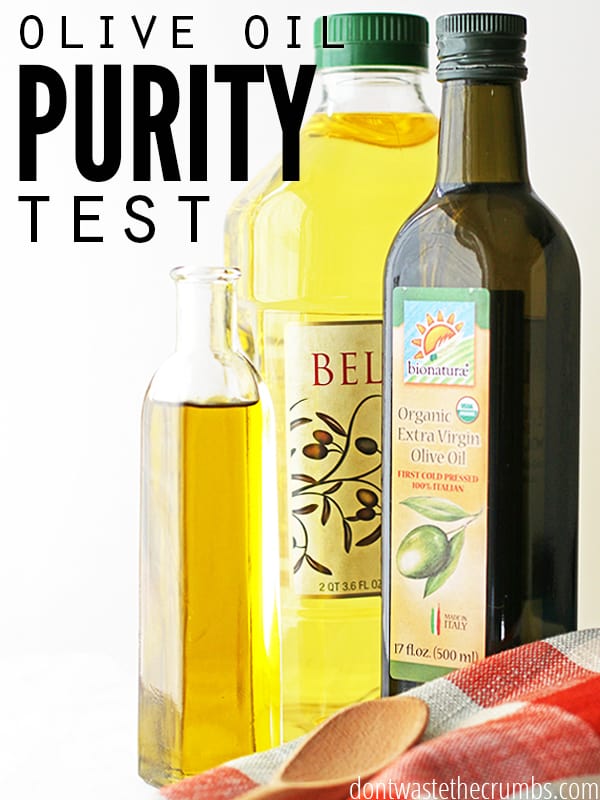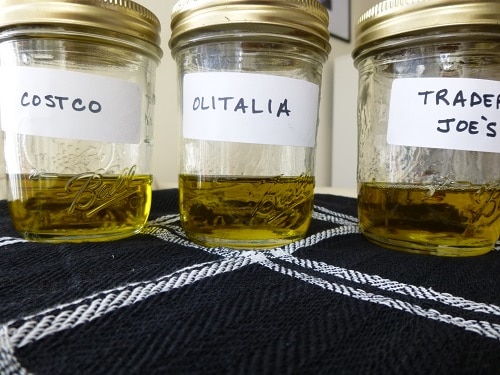
Mr. Crumbs sent me an article last month that made my jaw drop. After reading it, I felt cheated and deceived. It was tempting to copy and paste the whole thing for you guys to read, but instead I set it aside specific for today’s post.
According to the article, the U.S. Pharmacopeial Convention (USP) told ABC news that one of the easiest foods that can be tampered with is olive oil, since it can be diluted with cheaper oils and we as consumers won’t know the difference.
Another commonly altered food was lemon juice, where researchers found as little as 15% and 25% lemon juice in bottles labeled 100% pure lemon juice. YIKES!
The article made me wonder… what if the olive oil we buy is really only 15% olive oil? What if the rest of the jug is filled with the icky “yellow vegetable oil” that we’ve been striving so hard to avoid?
And then my next thought made me slightly angry: Am I REALLY paying a premium price for a no-nutrition oil that’s being masked as a higher quality product because it’s in a fancier bottle?!
Fortunately there’s a very simple test to ensure our olive oils really are made with olives, and they’re not being diluted with lesser quality imposters.
Remember from Monday how olive oil is liquid at room temperature yet solid when refrigerated? And remember from early in our Truth About Fat series that polyunsaturated oils (the yellow vegetable kind) are liquid at both room temperature AND when refrigerated.
Those are the standards by which we judge: whether or not it turns a solid!
Two Step Olive Oil Purity Test
- Pour 2-4 tbsp of olive oil into a clean glass jar. Seal the jar.
- Put the jar in the refrigerator for 24 hours.
- If the oil solidifies, it’s monounsaturated and is olive oil.
- If the oil remains a liquid, it is polyunsaturated and is NOT olive oil.
Three different brands of olive oil have come through my front door so far this year, so I took a small sample of each of these oils and ran it through the test above. Curious about the results? First, let’s talk about the oils.
Contender #1: Costco
Costco’s prices are very competitive, and their products are usually good quality. Naturally this is a place to go for something you want to be good, yet affordable (and don’t mind having a lot of). $11.49 for a 2 liter container.
The Statistics:
- Extra Virgin Olive Oil.
- Labeled “first cold pressed.”
- No harvest date, but has an expiration date of February 7, 2014 (purchased March 2013)
- Dark, opaque plastic container.
- Stored in a closet where the temperature is always approximately 68 degrees.
- No mention of NAOOA on the bottle.
Contender #2: Olitalia
This bottle was a Grocery Outlet find and experiment. I had never heard of this brand (despite the bottle saying “the olive oil brand most distributed in the world”), but we needed olive oil and I had a coupon. $6.99 for a 1 L container.
The Statistics:
- Extra Virgin Olive Oil.
- Labeled “first cold pressed.”
- No harvest date nor expiration date. Contains Lot number and time stamp.
- Dark, opaque glass container.
- Stored in a closet where the temperature is always approximately 68 degrees.
- No mention of NAOOA on the bottle.
Contender #3: Trader Joe’s
Trader Joe’s carries a few different varieties of olive oil. This one was simply the cheapest on the shelf – $5.49 for 1 liter, and I bought it for two reasons: a) per liter, the price beat out Costco, and b) it’s a lot easier to pour oil from a 1L container than a 2L jug.
The Statistics:
- Extra Virgin Olive Oil.
- Labeled “cold pressed.”
- Harvest date/expiration date unknown (I accidentally recycled the bottle 🙁 )
- Medium, opaque glass container.
- Stored in a closet where the temperature is always approximately 68 degrees.
- NAOOA data unknown (darn that recycle bin!)

The Two Step Olive Oil Purity Test:
I poured 2 ounces of each oil into separate glass containers and put them in the fridge, on the top shelf, at the very back, Saturday after dinner.
The Result:
After 12 hours, two of the three oils had completely solidified. I was surprised to see one oil still liquid, so I kept the oils in the fridge until evening.
After 24 hours, all three oils had completely solidified. Which one took longer than the others?

Costco.
This doesn’t mean Costco’s olive oil is bad or even watered down with other oils that aren’t derived from olives. It did – after a full day – solidify. But there is no explanation why it took twice as long to get to the same result. I even re-arranged the line-up of the jars in the fridge, thinking that their placement had something to do with it (although they were at the very coldest spot in the fridge… beef on the same shelf nearly froze during the test).
The oil being “old” doesn’t explain it either, since I had bought it early March and opened the container just for the experiment – I haven’t even really used it yet!
Now What?
Honestly, my gut tells me to return the Costco olive oil. Given the simple and consistent standards of the test, it should have passed just as easily as the other oils.
Another reason I’m returning the bottle is because I’m making a commitment to no longer cook with olive oil at high temperatures. We’ve been good about it for the past couple months, but I want to be even more so going forward. This means that opportunities to use 2 liters of olive oil are going to be far less.
Going forward it would be better to buy the smaller 1L glass jars of olive oil from Trader Joe’s, even if I have to buy two at a time. Another option would be to continue trying out random brands from Grocery Outlet. They’re prices are competitive, but now that I know what to look for (using these guidelines for buying), I can be even more discerning on the quality of oil. The Olitalia oil was actually really tasty!
UPDATE: Just a few weeks after this post was published I sifted through all of the the data left in the comments below, and even more. Read the science (and non-science) and determine for yourself whether or not the fridge test is valid!
Where to find Quality Olive Oil
Considering from the test I ran that Costco olive oil may not be the best. And not everyone has a Trader Joe’s or Grocery Outlet, you might need some ideas on where to find good olive oil! Use your price book to compare prices at your local stores.
If you prefer online shopping Amazon has some good options as well as Thrive Market. I trust the brands at Thrive Market to be solid sources. Amazon is a little riskier unless you are sure to research the brand you buy.







I did the experiment with the olive oil of Cobram Estate to see if it was pure extra virgin olive oil, it was still liquid after 24 hours at the back of the fridge, I paid AUS $25 for 1/2 litre and there are other oils added. I am not happy about them cheating but what can I do?
I tested the two liter bottle of Kirkland 100% Pure EV olive oil we just bought by leaving it in the fridge at 34 degrees farenhight. For two days. It has remained liquid with little change in viscosity. I’m disappointed and plan to reasearh further.
thank you for this article, and I appreciated the comments afterward.
I had learned from Sally Fallon and Mary Enig that saturated fats are the best for you, and of course, that polyunsaturated oils are bad for you.
I also understood from them that saturated fats are fine for high-heat cooking,since they tend not to break down and thus become toxic. So, I always assumed that high-heat cooking with olive oil was okay, though I also use coconut oil. What’s the truth about cooking with olive oil?
Hi, our friend Katie over at Kitchen Stewardship wrote a great article about this: https://www.kitchenstewardship.com/cooking-with-olive-oil/. She used to not heat olive oil but decided the research now shows it’s fine.
thank you for the link
We just found your discussion and bought the California Olive Ranch Destination Series EVOO “chef size” from Walmart in the dark green, plastic bottle. Sadly, 13 hours in the refrigerator and NO SOLIDS! We do cook a lot with coconut oil, but my daughter breaks out w/skin acne evertime we use coconut oil or coconut flour. Looking for an alternative!
Have you tried avocado oil? I just tried it recently (from ALDI) and really like it!
I have read recently lots of articles about two oils.
One is called Sesame oil the other Is Called Perulla oil. To no evaluation I have checked up all the major shops in The neighbourhood in London even the ones with natural ingredients.
Thanks for the articles.
Well, I am disappointed to read that as I just replaced Carbonell EVOO, which failed the refrigerator test, with California Olive Ranch. ( we have bought many other popular brands that state they are products from multiple countries as well) I didn’t perform the test on the California brand when I bought it, but the taste/flavor and texture was so different than the other oils we have been buying was leading me to believe that this oil the real deal. SO,.. now I put a few ounces of the California oil in the fridge and I have my fingers crossed that I have not been mislead again. :-/
There’s a list—a massive list—online that names all the verified genuine olive oils, and presumably it will be updated year by year. There are also smaller lists, in 15 to 25 increments. And a few that are more specific, including one that takes on Trader Joes “virgins and floozies”. Trader Giotto Olive Oil (not EV or V) is on this list and said to have labeling on the back that lists the origins of this “Italian” olive oil as coming from Italy, and not so Italian Greece, Spain, and Portugal. All countries where fake olive oil exports are rife.
Problem is, few lists help the shopper with plain olive oil—not EV or V—which I want to buy for soap making.
Had the same result. It did not solidify whatsoever. The problem I have with this is it false advertising I’ve been trusting this company and it’s all fake. I don’t know what’s in this oil and I try to really eat healthy on my budget. I’m now buying direct from the oil mill in Arizona. It’s an olive farm.
I did the test with Costco extra virgin and got about 75% solidification after 48 hrs at 37 degree temp
We tried another brand from Trader Joe’s. Sicilian Selezion. NO solidification. 🤬
On to another
seeeemes like if the olive oil does not get solid at all pass it up …the more solid the better guality/ keep it simple
Just read your thread. I live in Savannah, Georgia but own a very small olive farm in Tuscany. We produce olive oil purely for our own consumption and not for retail. This year we have hand picked and processed about half a ton of olives and they have produced about 75 liters of evoo. I cannot fly from Italy to USA with this amount of oil so I come back by ship. There is no problem importing olive oil for you own consumption. The taste of the oil changes in the first three months as does the color and texture. Oil from different regions has it’s own characteristics. Just having the oil pressed costs over $100 and hand picking is not very cost effective. Buyers will pay over $15 per liter for this product. Even with machine picking, the trees still have to be netted. I cannot see that any oil costing less than $10 per liter will be 100% evoo.
Tiffany, does the North American Olive Oil Association have credibility? Or are they just another trade association touting their member’s products…
John
They do have credibility John, as there’s no government association for oil. They’re more of a trade association, but they have high standards and their weight carries a good bit.